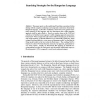Free Online Productivity Tools
i2Speak
i2Symbol
i2OCR
iTex2Img
iWeb2Print
iWeb2Shot
i2Type
iPdf2Split
iPdf2Merge
i2Bopomofo
i2Arabic
i2Style
i2Image
i2PDF
iLatex2Rtf
Sci2ools
IPM
2008
2008
Searching strategies for the Hungarian language
This paper reports on the underlying IR problems encountered when dealing with the complex morphology and compound constructions found in the Hungarian language. It describes evaluations carried out on two general stemming strategies for this language, and also demonstrates that a light stemming approach could be quite effective. Based on searches done on the CLEF test collection, we find that a more aggressive suffix-stripping approach may produce better MAP. When compared to an IR scheme without stemming or one based on only a light stemmer, we find the differences to be statistically significant. When compared with probabilistic, vector-space and language models, we find that the Okapi model results in the best retrieval effectiveness. The resulting MAP is found to be about 35% better than the classical tf idf approach, particularly for very short requests. Finally, we demonstrate that applying an automatic decompounding procedure for both queries and documents significantly improve...
Aggressive Suffix-stripping Approach | General Stemming Strategies | IPM 2008 | Light Stemming Approach |
Related Content
| Added | 12 Dec 2010 |
| Updated | 12 Dec 2010 |
| Type | Journal |
| Year | 2008 |
| Where | IPM |
| Authors | Jacques Savoy |
Comments (0)

